Root out friction in every digital experience, super-charge conversion rates, and optimize digital self-service
Uncover insights from any interaction, deliver AI-powered agent coaching, and reduce cost to serve
Increase revenue and loyalty with real-time insights and recommendations delivered to teams on the ground
Know how your people feel and empower managers to improve employee engagement, productivity, and retention
Take action in the moments that matter most along the employee journey and drive bottom line growth
Whatever they’re are saying, wherever they’re saying it, know exactly what’s going on with your people
Get faster, richer insights with qual and quant tools that make powerful market research available to everyone
Run concept tests, pricing studies, prototyping + more with fast, powerful studies designed by UX research experts
Track your brand performance 24/7 and act quickly to respond to opportunities and challenges in your market
Explore the platform powering Experience Management
- Free Account
- For Digital
- For Customer Care
- For Human Resources
- For Researchers
- Financial Services
- All Industries
Popular Use Cases
- Customer Experience
- Employee Experience
- Employee Exit Interviews
- Net Promoter Score
- Voice of Customer
- Customer Success Hub
- Product Documentation
- Training & Certification
- XM Institute
- Popular Resources
- Customer Stories
- Market Research
- Artificial Intelligence
- Partnerships
- Marketplace
The annual gathering of the experience leaders at the world’s iconic brands building breakthrough business results, live in Salt Lake City.
- English/AU & NZ
- Español/Europa
- Español/América Latina
- Português Brasileiro
- REQUEST DEMO
- Experience Management
- Customer Journey Mapping
- Consumer Decision Journey

See how XM for Customer Frontlines works
The consumer decision journey.
14 min read Understanding the consumer decision journey – and working with what you learn – can help your marketing efforts, customer support teams, and product rollouts thrive. Here’s everything you need to know…
Author: Adam Bunker
Subject Matter Expert: Dave Pabley
What is the consumer decision journey?
The ‘consumer decision journey’ is the name given to a framework that deconstructs and explores the myriad factors that go into customer purchases. In other words: it’s the way we make sense of the consumer decision-making process.
Did you know that 70% of buyers fully define their own purchasing needs before they engage with sales people? If not, you might need to rethink what your customer decision journeys look like, and how you work to manage them.
Every time a customer buys something from a brand, it’s the result of a complicated set of processes and influences that – often – they’ve experienced in a nonlinear fashion. The consumer decision journey is a means to map and understand that path, with a view to try and meet potential future customers at every touchpoint along the way.
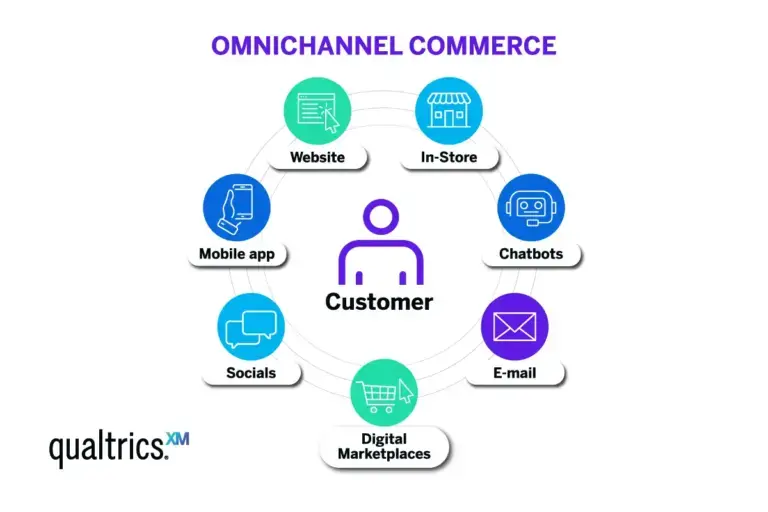
Understanding how and why new and previous customers make purchases is the holy grail of every marketing department in the world. And if you can actually influence those factors with your CX and marketing strategy? Even better. Doing that means unpicking the complicated rationale and stop-start nature of today’s buying journeys.
Understanding the consumer decision journey is really about asking a few key questions:
- How can you meet your customers at important touchpoints?
- How can you maximize each interaction?
- What goes into each purchase decision?
If you have answers to those questions, you’ll go a long way toward ensuring you have the right processes, resources, and technology in place to help your business grow its customer base. You’ll know how and when to upsell, how to convert prospects, and what influences each and every purchase.
That’s a complicated task, but digging into customer analysis can really pay off – in some pretty meaningful ways.
Free course: Elevate your customer journey management today
‘Customer managed’ journey versus a ‘managed customer’ journey
Today’s customer is increasingly empowered in their decision-making, since they have access to much more choice, information, and branded content across a range of channels.
As such, it’s important that brands understand their role in the decision-making process. In most instances, things can’t be controlled in a streamlined way on the brand side – it’s the customer in control. That means organizations need to be adaptable, responsive, and able to meet the customer where they are, rather than the other way round.
While you might map out a perfect, best-case journey for your customer personas – a managed customer journey – things may not pan out that way. This gives rise to the idea of the ‘customer managed’ journey instead – one where your customers call the shots in terms of how they make their decisions, and you cater as best you can to their preferences.
Why is the consumer decision journey important?
Customer interactions and the journeys they create are more complicated, nonlinear, and omnichannel than ever. But that presents an opportunity: the brands that can leverage the tools at their disposal to unpick that complicated knot stand a great chance at winning over more customers than their competitors.
Today’s customers aren’t easily influenced or led down a specific path. Whereas in decades gone by you might easily nurture a customer down the sales funnel with a compelling TV ad and then an in-store salesperson, things are different now. In fact, even if you manage to get customers into your physical store, some 71% of them will still be using their phones to look up reviews or even to make their purchases.
95% of consumers read online reviews before making purchases, which can take the wind out of any marketing efforts’ sails if there’s no real strategy in place to maximize other customer journey touchpoints. In fact, chances are that by the time a customer speaks to a representative, they’re already most of the way along the buying process.
That means meeting your customers where they are – like online influencer accounts, for example, which 55% of 18-24-year-olds rely on.
Whatever the case, it’s important to understand the factors that influence buying decisions because that lets you personalize and tailor those experiences as best you can to capture more interest.
Beyond this though, getting to grips with the consumer decision journey means understanding that the journey doesn’t end with a purchase – that’s just part of a cyclical experience.
So let’s explore how that works…
Understanding how consumers make decisions
In the traditional purchasing funnel, customers move along the stages from awareness to purchasing and customer loyalty linearly, beginning with a widely cast net of possible brands, and ending with just one. But that model’s now outdated.
Today, customers move from touchpoint to touchpoint in a way that makes it impossible to put importance on any one part of the funnel over any other. Instead, the decision journey is cyclical – and capturing attention needs to be handled as part of a two-way conversation at every stage.
McKinsey’s research , involving some 20,000 consumers, has resulted in a new framework for the decision journey that it describes as having four interlinked phases:
“The decision-making process is a more circular journey, with four primary phases representing potential battlegrounds where marketers can win or lose: initial consideration; active evaluation, or the process of researching potential purchases; closure, when consumers buy brands; and postpurchase, when consumers experience them.”
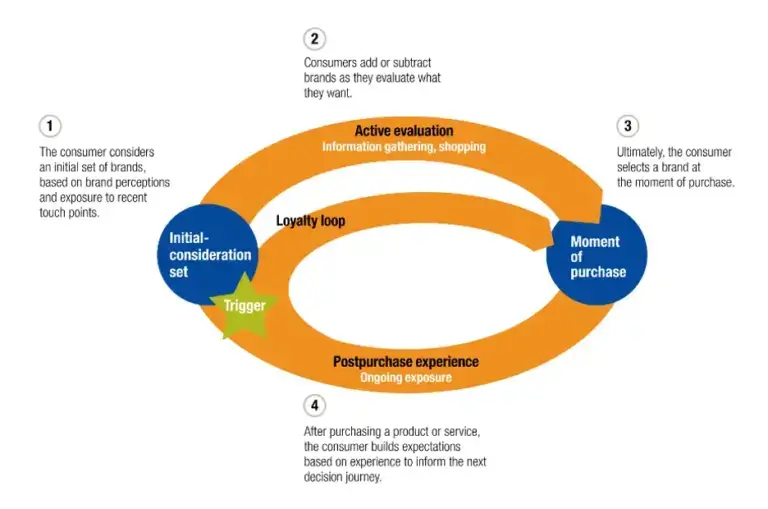
Image credit: McKinsey.com
In fact, the journey here is more of a spiral than a circle; it’s in that fourth, post-purchase stage where the decision journey becomes a ‘loyalty loop’ that can repeat itself forever. McKinsey puts forward the following roadmap for those latter stages:
- Purchasing: After initial consideration, the customer makes a purchase
- Experiencing: The customer forms opinions on the product or service
- Advocating: The customer spreads the word
- Bonding: The customer becomes a loyal customer who makes repeat purchases
Tools and processes for enhancing customer journeys
Understanding the modern customer journey and adapting to it are two very different things. Customers expect more than ever before from their brands in terms of personalization , relevance, and the ability to meet them where they are, on the channels they care about.
That means that customer experience and marketing teams need to employ processes that can make every touchpoint work harder. Usually, that means using a mix of surveys , customer experience analytics software , and behavioral data to finetune every channel and provide more powerful, personal and adaptable experiences.
Let’s take a look at some of the methods, tools and processes you can use to do exactly that, across three key areas:
1. Omnichannel engagement
Your customers are moving between channels and platforms in search of the information they need to make informed purchasing decisions. You need to be where they are.
Customer touchpoint analysis
Take stock of every touchpoint in which customers can interact with your brand. That’s everything from your website to your customer service portal, as well as TV ads, social media channels and third-party review sites.
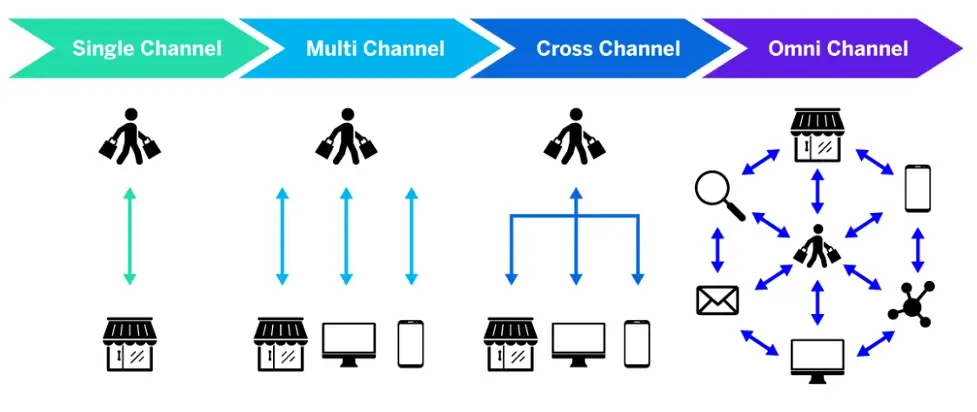
Your first step here is to lean into digital analytics to understand your share of voice, your conversion rate on call-to-action links, and anywhere you’re underrepresenting yourself. This stage is an audit, in effect – are you meeting people where they already are?
Omnichannel customer engagement
Once you understand every touch point, you need to think about how you can tie them together. Customers may jump from one touchpoint to the next in any order, so you need to be able to offer them a consistent experience that’s channel-agnostic.
That’s as important in marketing as it is in customer service – both rely on being able to track customer movements and proactively engage with people.
Customer journey optimization
Journey optimization starts with customer journey mapping exercises, in which you use customer data and your own insight to map out potential routes your customers take toward purchase. How can those journeys be tightened and streamlined? Hypothesize around this, make changes, and then test to see whether things improved.
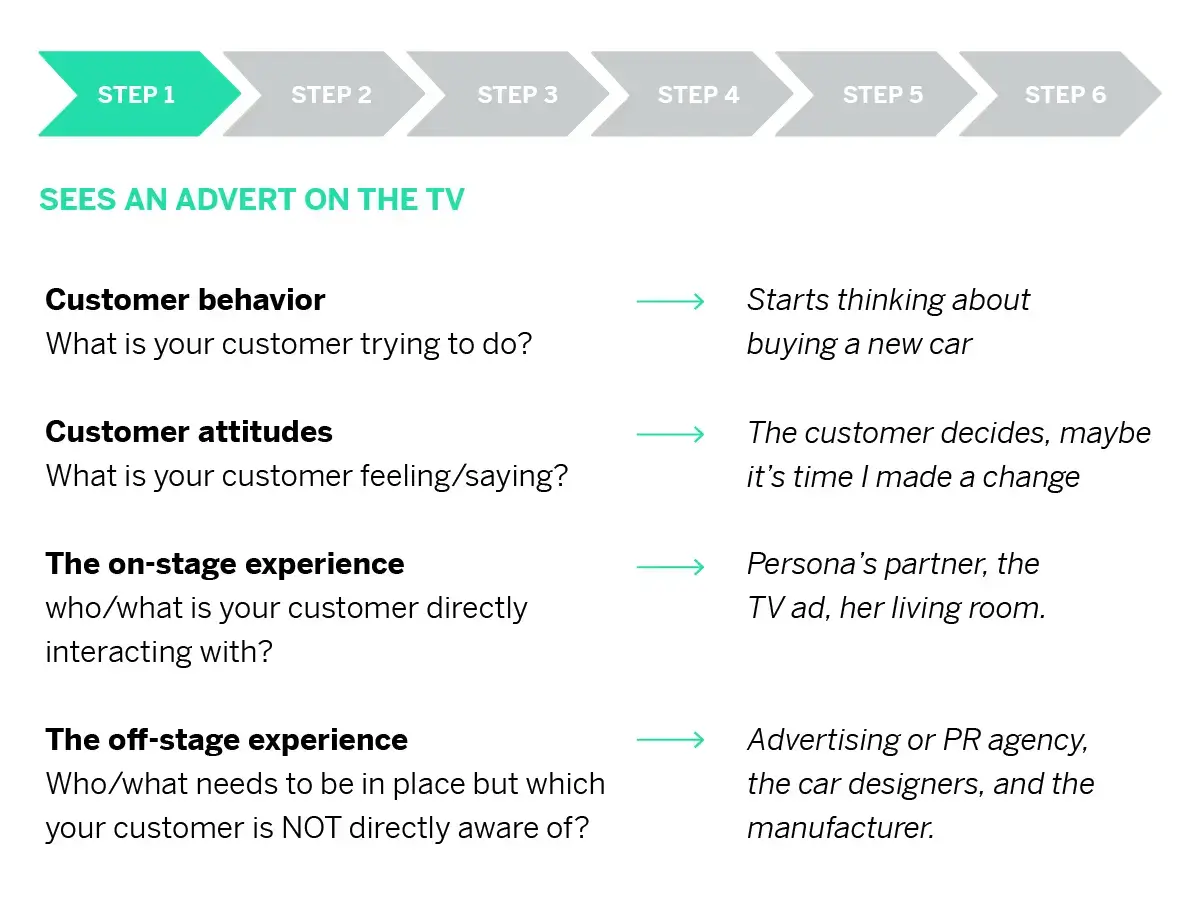
2. Behavioral analysis
How well do you understand what makes your customers tick? With the right software, you’ll be able to glean invaluable insights from the actions your customers do and don’t take.
Consumer behavior analysis
Understanding customer behavior allows you to adapt things to suit them – and identify where pain points and areas of friction lie. You’ll achieve this by using customer experience analytics suites capable of understanding behavioral heuristics.
These tools can identify patterns, show you how different audience segments act, and how purchasing decisions act as part of a wider whole.
Behavioral targeting strategies
Imagine if you knew that a specific customer always shops for a certain kind of product at certain times of the year, that they’re much more likely to make a purchase if there’s a discount with their name on it, or if bundling two items together will make them much more appealing than the sum of their parts.
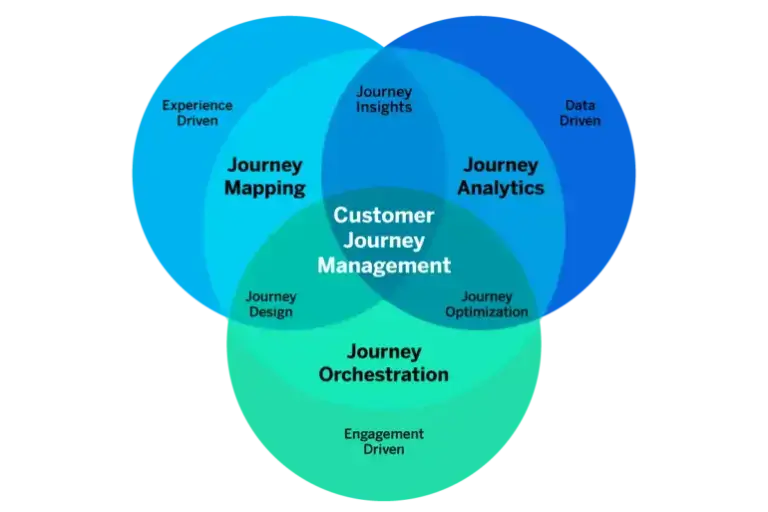
These are examples of behavioral targeting strategies that require a rock-solid understanding of each and every customer – and customer segment. Tools like Experience ID can help you gather that understanding, and tailor your efforts accordingly.
Refining the purchase decision process
It’s important to understand areas of your customer experience that are letting things down – and negatively impacting the customer buying process. If you can track customers as they move through your owned digital properties, you’ll have a clear idea of where people are dropping off, and why shopping carts are being left abandoned.
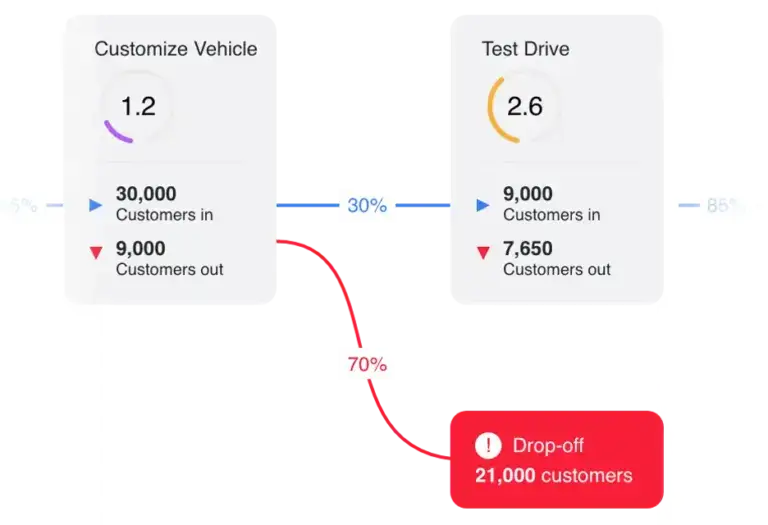
With that information, you can make proactive changes to the user experience in order to refine that initial consideration stage and better influence consumer purchasing behavior.
Learn more about customer behavior analysis
3. Postpurchase excellence
Once a customer has made a purchase, they’ll move into that inner ‘loyalty loop’ track of the consumer decision journey. This is your chance to wow them with postpurchase excellence – and generate real loyalty .
Customer experience analytics
Customer experience analytics is the process of collecting and analyzing customer data so that you can better understand customer needs, viewpoints, and experiences. This will help you to increase customer engagement and customer loyalty at every part of their journey – not just after making a purchase.
If you can understand the experience as it stands for existing customers, you’ll be able to direct your internal teams to take action on issues that are affecting satisfaction and loyalty.
Curating the customer engagement journey
Customer service is a huge part of postpurchase (repeat) purchase decisions. If a customer has had a positive customer support experience, they’re much more likely to buy from you again. So it’s important that this side of the customer experience is being monitored and managed.
Contact center management tools with AI and natural language processing can help here, by scanning and understanding every interaction every customer has with your business and proactively suggesting where things can be improved. That could be through trends that a bunch of different customers all mention, or by spotting opportunities for support agent coaching.
Customer lifecycle management
To keep customers coming back, you need to be able to keep a good eye on their behavior and ensure that if they have feedback, you’re able to close the loop by making the changes they want to see.
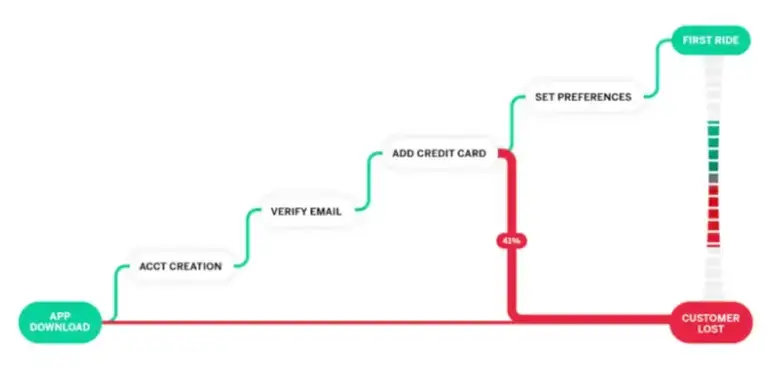
That’s alongside continually delighting them with proactive, personalized offers and communications. Keeping customers for the long haul means fostering a human-centric approach that uses software, surveys and analytics to help you show just how much you value their business.
Delivering customer-driven journeys
The consumer decision journey represents a complex, ever-evolving landscape that demands a really nuanced and adaptive approach from businesses. In an era where digital platforms dominate and consumer behaviors shift rapidly, understanding journeys from a scientific perspective is not just beneficial – it’s imperative for sustained success.
By embracing journey insights, businesses can position themselves at critical touchpoints, offering personalized solutions that resonate with consumers’ needs and preferences at the right moments. Integrating advanced analytics, omnichannel strategies and customer-centric thinking is what’ll help you exceed the expectations of today’s savvy consumers.
In other words? As you navigate this dynamic terrain, the key to unlocking customer loyalty and driving business growth lies in the ability to continuously adapt, innovate, and deliver exceptional experiences at every stage of the consumer decision journey.
Ready to transform your understanding of the consumer decision journey? With Qualtrics® Customer Journey Optimizer , you can take your customers where they want to go—in the fastest and most profitable way.
Elevate your customer journey management today
Related resources
Customer Journey
Customer Journey Orchestration 12 min read
Customer journey management 14 min read, customer journey stages 12 min read, buyer's journey 16 min read, customer journey analytics 13 min read, create journey map 24 min read, b2b customer journey 13 min read, request demo.
Ready to learn more about Qualtrics?

Definition and examples of the consumer decision-making process
Lucid Content
Reading time: about 6 min
What is the consumer decision making process
The consumer decision-making process involves five basic steps. This is the process by which consumers evaluate making a purchasing decision. The 5 steps are problem recognition, information search, alternatives evaluation, purchase decision and post-purchase evaluation.
5 steps of the consumer decision making process
- Problem recognition : Recognizes the need for a service or product
- Information search : Gathers information
- Alternatives evaluation : Weighs choices against comparable alternatives
- Purchase decision : Makes actual purchase
- Post-purchase evaluation : Reflects on the purchase they made
The consumer decision-making process can seem mysterious, but all consumers go through basic steps when making a purchase to determine what products and services will best fit their needs.
Think about your own thought process when buying something—especially when it’s something big, like a car. You consider what you need, research, and compare your options before making the decision to buy. Afterward, you often wonder if you made the right call.
If you work in sales or marketing, make more of an impact by putting yourself in the customer’s shoes and reviewing the steps in the consumer decision-making process.
Steps in the consumer decision process
Generally speaking, the consumer decision-making process involves five basic steps.
1. Problem recognition
The first step of the consumer decision-making process is recognizing the need for a service or product. Need recognition, whether prompted internally or externally, results in the same response: a want. Once consumers recognize a want, they need to gather information to understand how they can fulfill that want, which leads to step two.
But how can you influence consumers at this stage? Since internal stimulus comes from within and includes basic impulses like hunger or a change in lifestyle, focus your sales and marketing efforts on external stimulus.
Develop a comprehensive brand campaign to build brand awareness and recognition––you want consumers to know you and trust you. Most importantly, you want them to feel like they have a problem only you can solve.
Example: Winter is coming. This particular customer has several light jackets, but she’ll need a heavy-duty winter coat if she’s going to survive the snow and lower temperatures.
2. Information search

When researching their options, consumers again rely on internal and external factors, as well as past interactions with a product or brand, both positive and negative. In the information stage, they may browse through options at a physical location or consult online resources, such as Google or customer reviews.
Your job as a brand is to give the potential customer access to the information they want, with the hopes that they decide to purchase your product or service. Create a funnel and plan out the types of content that people will need. Present yourself as a trustworthy source of knowledge and information.
Another important strategy is word of mouth—since consumers trust each other more than they do businesses, make sure to include consumer-generated content, like customer reviews or video testimonials, on your website.
Example: The customer searches “women’s winter coats” on Google to see what options are out there. When she sees someone with a cute coat, she asks them where they bought it and what they think of that brand.
3. Alternatives evaluation
At this point in the consumer decision-making process, prospective buyers have developed criteria for what they want in a product. Now they weigh their prospective choices against comparable alternatives.
Example: The customer compares a few brands that she likes. She knows that she wants a brightly colored coat that will complement the rest of her wardrobe, and though she would rather spend less money, she also wants to find a coat made from sustainable materials.
4. Purchase decision
This is the moment the consumer has been waiting for: the purchase. Once they have gathered all the facts, including feedback from previous customers, consumers should arrive at a logical conclusion on the product or service to purchase.
If you’ve done your job correctly, the consumer will recognize that your product is the best option and decide to purchase it.
Example: The customer finds a pink winter coat that’s on sale for 20% off. After confirming that the brand uses sustainable materials and asking friends for their feedback, she orders the coat online.
5. Post-purchase evaluation
This part of the consumer decision-making process involves reflection from both the consumer and the seller. As a seller, you should try to gauge the following:
- Did the purchase meet the need the consumer identified?
- Is the customer happy with the purchase?
- How can you continue to engage with this customer?
Remember, it’s your job to ensure your customer continues to have a positive experience with your product. Post-purchase engagement could include follow-up emails, discount coupons, and newsletters to entice the customer to make an additional purchase. You want to gain life-long customers, and in an age where anyone can leave an online review, it’s more important than ever to keep customers happy.
Tools to better understand your customer
Putting yourself in the customer’s shoes can help you steer consumers towards your product. Here are some tools to help you analyze their decision-making process and refine your brand marketing and sales tactics.
Customer journey map
A customer journey map visualizes a hypothetical customer’s actions. Use it to empathize with your customers as they go through a specific process or try to complete a purchase. Map out the actions the customer is likely to take.
Learn how to make a customer journey map to understand the decision-making process for your product/service.

Empathy map
Empathy maps help teams understand the customer’s mindset when dealing with a product or service. They can be used for personas or specific customer types. Empathy mapping is often most helpful at the beginning of a new project. Collaborate as a team to quickly get inside the heads of your customers during every step of product development, testing, and release.
Learn how empathy maps work so you can understand your customers better and make customer-oriented decisions .

User personas
Based on user research or past user interactions, user persona cards construct fictional or composite personas that break down and organize your data into distinctive types of users. Build a more human picture of your users and understand your user base better by creating user personas for the various types of users for your product or service.

Understanding the consumer decision-making process is key if you want to attract more customers and get them to make that crucial purchase. Use this process and the tools above to tune in to consumers and genuinely understand how to reach them.

Visualize your own customer journey map.
Lucidchart, a cloud-based intelligent diagramming application, is a core component of Lucid Software's Visual Collaboration Suite. This intuitive, cloud-based solution empowers teams to collaborate in real-time to build flowcharts, mockups, UML diagrams, customer journey maps, and more. Lucidchart propels teams forward to build the future faster. Lucid is proud to serve top businesses around the world, including customers such as Google, GE, and NBC Universal, and 99% of the Fortune 500. Lucid partners with industry leaders, including Google, Atlassian, and Microsoft. Since its founding, Lucid has received numerous awards for its products, business, and workplace culture. For more information, visit lucidchart.com.
Related articles

Use this guide to learn how to make a decision tree in Microsoft Excel—either directly in Excel using Shapes or using a simple Lucidchart integration.

Whether you specialize in a specific marketing role or you wear many different hats on a small team, we’ve rounded up nine marketing templates to make your job easier.
Bring your bright ideas to life.
or continue with
- Skip to main content
- Skip to primary sidebar
- Skip to footer
- QuestionPro

- Solutions Industries Gaming Automotive Sports and events Education Government Travel & Hospitality Financial Services Healthcare Cannabis Technology Use Case NPS+ Communities Audience Contactless surveys Mobile LivePolls Member Experience GDPR Positive People Science 360 Feedback Surveys
- Resources Blog eBooks Survey Templates Case Studies Training Help center
Consumer Decision Journey: What it is + Free Guide
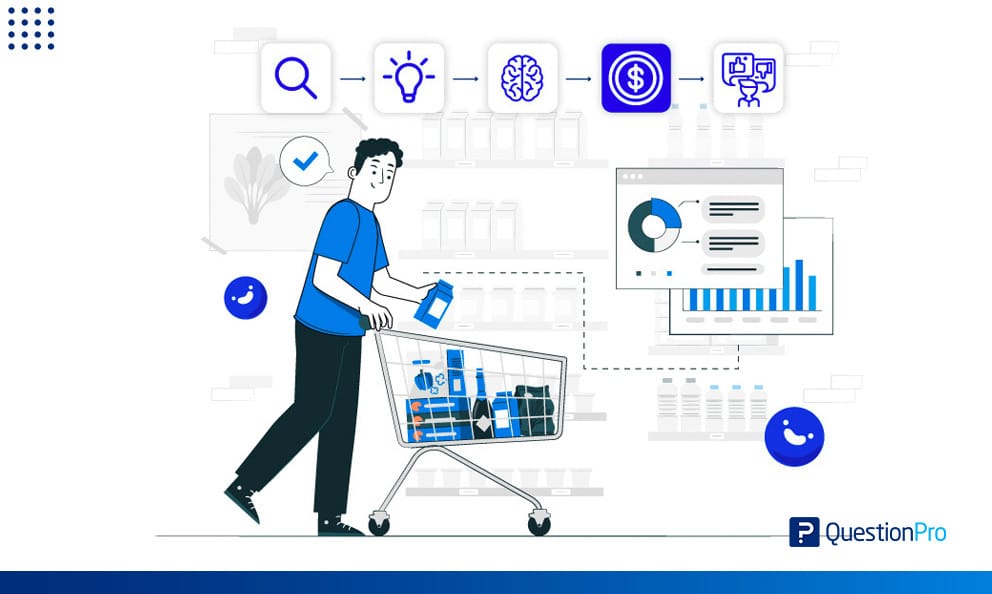
Talking about a consumer decision journey is essential for any sales, marketing, and customer experience strategy . More and more customers are skipping the established schemes in the classic funnels and making decisions based on new factors in the match.
If you want to get to know this concept in-depth, in this article, you will find what it consists of, its main stages, and how to generate a successful journey for your clients.
Content Index
What is the consumer decision journey?
Importance of the consumer decision journey, stages of the consumer decision journey, how to guide a good customer decision journey, create your successful consumer decision journey with questionpro.
The consumer decision journey is a model of the customer buying process that describes how consumers make their decisions throughout their experience or relationship with the brand. This model evaluates how it can influence the customer’s purchase decision process by recognizing key touchpoints and customer interactions.
The consumer’s decision journey is not a linear model, so the actions they describe overlap and repeat until the purchase decision. The importance of factors such as customer loyalty and post-sale strategies is highlighted.
LEARN ABOUT: Perfect Customer-First Strategy
Understanding the consumer decision journey is vital because it can help a business understand how and when to engage with customers throughout their journey, from brand discovery to post-purchase and beyond.
This framework helps marketers better understand the key customer touchpoints where the right message to the right consumer can change their behavior.
The consumer decision journey model can help companies make continual improvements to customer lifetime value experience and lifecycle, fueling brand loyalty for years to come.
LEARN ABOUT: Customer Lifecycle
The consumer decision journey (CDJ) is an important part of brand marketing, marketing campaign, and figuring out how people act. It’s the process people go through when deciding what to buy, from realizing they need or want something to weighing their options to the experience they have after buying something.
From the following points of view, you can see how important the consumer decision journey is:
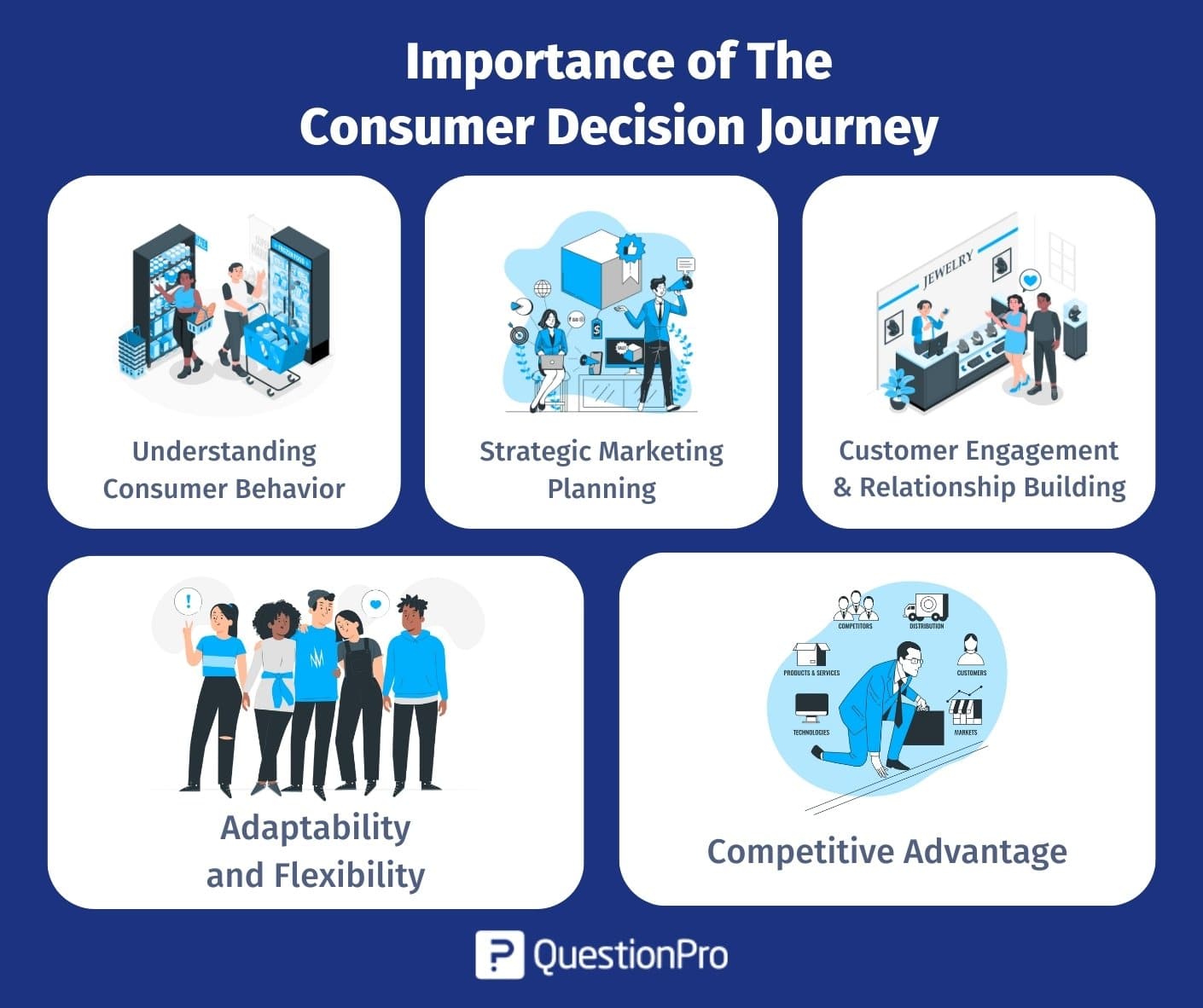
Understanding consumer behavior
The CDJ gives useful information about what people think, feel, and do during buying. By looking at the different steps of the CDJ, marketers can learn more about consumer purchasing behavior and what drives consumers, what their preferences are, and what makes them make decisions. This helps businesses change their marketing strategies and messages so they can connect with customers at each stage of their trip.
Strategic marketing planning
By making a map of how a consumer makes a decision, marketers can find the key touchpoints and interactions where that can affect a consumer’s choice. Businesses can make the most of their marketing resources by strategically allocating them to touchpoints like online research, social media interaction, and in-store experiences. It lets marketers build targeted marketing campaigns and personalized experiences that resonate with customers at every stage of their journey.
Customer engagement and relationship building
The CDJ knows that a consumer’s trip doesn’t end when they buy something. It talks about how important the experience after a purchase is and how it can create loyal customers and company advocates. Businesses can build long-term relationships with their customers by focusing on giving great customer service, asking for feedback, and staying in touch. This can lead to repeat purchases and good word-of-mouth recommendations.
Adaptability and flexibility
The path a consumer takes to make a choice is not a straight line. Today’s consumers have access to a wide range of channels, platforms, and information sources that can affect their decisions at any point. By understanding that the CDJ is always changing, companies can change their marketing plans to keep up with consumer behavior and preferences changes. This ability to change helps businesses stay relevant and connect with customers in a digital world that is always changing.
Competitive advantage
Knowing and improving the consumer decision journey can give a business an edge over its competitors. By looking at how people act and what they like, businesses can find holes or pain points in the market and come up with new goods, services, or marketing plans to fill them. By giving customers a smooth and personalized experience, companies can set themselves apart from their competitors and give customers a positive and memorable experience.
Build your own Customer Journey Map .
The consumer decision journey consists of 5 main stages:
- The trigger
- The search for information
- The evaluation of alternatives
- The purchase
- The post-sale experience
Now we will detail each one.
1. Discovery
A stimulus or trigger starts the customer journey when an individual realizes they have a problem and need a company product or service to solve it.
The first step of the consumer’s decision journey is recognizing the need for a service or product.
LEARN ABOUT: Customer Journey Mapping Tools
2. Familiarization with the solution
When considering a purchase, a person reflects on a set of initial consideration or brands that immediately come to mind due to their level of brand awareness .
When researching their options, consumers will again rely on internal and external factors and previous interactions with a product or brand, both positive and negative.
Consumers can search for options in a physical place or consult online resources such as Google My Business Reviews and their degree of recommendation on various brands in the information or familiarization stage.
3. Consideration
Consumers gather information by searching multiple sources and reading reviews to decide which brand has what they want or need.
Alternatives can come in the form of lower prices, additional product benefits, immediate availability, or something as personal as color or style choices.
4. Purchase
Once the consumer filters their options based on the information they have gathered in the evaluation phase, they choose a brand and begin the purchase.
Once they have gathered all the data, including comments from previous customers, consumers must come to a logical conclusion about the product or service to buy.
5. Post-sale experience and loyalty
This part of the consumer decision journey involves both the consumer and the seller reflecting on the post-sale experience as part of the process.
As a seller, you should try to assess whether the purchase met the consumer’s identified need, whether the customer is delighted with the purchase, and how you can continue the relationship to ensure customer retention and loyalty.
LEARN ABOUT: Employee Experience Framework
Now that you know what the customer decision journey consists of, we will present you with five ways to guide your customers to ensure a smooth process that guarantees the satisfaction of their needs and your sales success.

Boost your company’s brand awareness
The first step to creating a successful consumer decision journey is to develop a comprehensive brand advertising campaign to build brand awareness. This way, existing customers will be able to think of you as part of the first options that come to mind when they think of you.
You want consumers to know and trust you. And more importantly, you want them to feel like they have a problem that only you can solve.
Map your consumer decision journey
Building Customer Journey Maps are critical to comprehend the client’s key moments and pain points to which you must pay special attention to guarantee a smooth experience.
Knowing how to map customer journeys is a skill that your Customer Experience team must have or develop as soon as possible to offer potential customers access to the information they need at the right time so that they decide to buy your product or service.
Creating a funnel and planning the types of content that people may need is also advisable. Present yourself as a trusted source of knowledge and information, and include consumer-generated content such as customer reviews or case studies of your solutions on your website.
Know your competition and surpass it
Your sales, marketing, and customer service strategies should convince consumers that your product is superior to alternatives.
For this, you must prepare to overcome any objection; for example, on sales calls or post-calls , get to know your competitors so you can answer questions and compare benefits.
Evaluate the experience throughout the consumer decision journey
Having reliable data in real-time is one of the best ways to evaluate the consumer decision journey to take improvement actions at critical points.
To do this, you can use various customer experiences metrics such as CSAT , CES, NPS , and the Things Gone Wrong index to understand the most essential moments and the most appropriate strategies for each point of the customer journey.
Keep your commitment to the client
Make sure your customer continues to have a positive experience with your products. Post-purchase customer engagement can include follow-up emails, discount coupons, and newsletters to entice the customer to make an additional purchase.
One way to ensure a successful consumer decision journey is to develop loyalty strategies that help you promote long-term customer interaction and word-of-mouth recommendations.
Suppose you want to go further and offer a wow experience. In that case, you can create a community of customers and invite them to actively participate to earn rewards, interact with other customers, and develop new business ideas.
LEARN ABOUT: Buying behavior
The consumer decision journey involves various business areas, from digital marketing strategy to generating attraction in the discovery stage to the customer service and experience team to complete post-sale and loyalty successfully.
For a successful customer satisfaction journey, you’ll need tools that help you measure every moment in real-time, see your metrics, automate processes, and connect the organization so your team can make decisions to resolve any friction instantly. If you would be interested in having all these tools in the same solution, remember that with QuestionPro CX you can have them at your fingertips at any time. Request a free demo or write to us in our online chat for more information!
LEARN MORE FREE TRIAL
MORE LIKE THIS

Customer Communication Tool: Types, Methods, Uses, & Tools
Apr 23, 2024

Top 12 Sentiment Analysis Tools for Understanding Emotions

QuestionPro BI: From research data to actionable dashboards within minutes
Apr 22, 2024

21 Best Customer Experience Management Software in 2024
Other categories.
- Academic Research
- Artificial Intelligence
- Assessments
- Brand Awareness
- Case Studies
- Communities
- Consumer Insights
- Customer effort score
- Customer Engagement
- Customer Experience
- Customer Loyalty
- Customer Research
- Customer Satisfaction
- Employee Benefits
- Employee Engagement
- Employee Retention
- Friday Five
- General Data Protection Regulation
- Insights Hub
- Life@QuestionPro
- Market Research
- Mobile diaries
- Mobile Surveys
- New Features
- Online Communities
- Question Types
- Questionnaire
- QuestionPro Products
- Release Notes
- Research Tools and Apps
- Revenue at Risk
- Survey Templates
- Training Tips
- Uncategorized
- Video Learning Series
- What’s Coming Up
- Workforce Intelligence
- SUGGESTED TOPICS
- The Magazine
- Newsletters
- Managing Yourself
- Managing Teams
- Work-life Balance
- The Big Idea
- Data & Visuals
- Reading Lists
- Case Selections
- HBR Learning
- Topic Feeds
- Account Settings
- Email Preferences
Competing on Customer Journeys
- David C. Edelman
- Marc Singer

As digital technology has enabled shoppers to easily research and buy products online, sellers have been scrambling after them, trying to understand and satisfy their wants. Savvy companies, however, are using new tools, processes, and organizational structures to proactively lead digital customers from consideration to purchase and beyond. They are creating compelling customer journeys and managing them like any other product—and gaining a source of competitive advantage.
Building successful journeys requires four key capabilities: automation, to smoothly carry customers through each step of their online path; personalization, to create a customized experience for each individual; contextual interaction, to engage customers and appropriately sequence the steps they take; and journey innovation, to add improvements that enhance and extend the journey and foster customer loyalty.
In addition, the most successful companies have a particular organizational structure, with a chief experience officer overseeing a journey-focused strategist and a “journey product manager.” This latter role is critical—the journey product manager leads a team of designers, developers, data analysts, marketers, and others to create and sustain superior journeys, and he or she is accountable for the journey’s ROI and general business performance.
You have to create new value at every step.
Idea in Brief
The problem.
Digital tools have put shoppers in the driver’s seat, allowing them to easily research and compare products, place orders, and get doorstep delivery of their items. Sellers have largely been reactive, scrambling to position themselves where customers will find them.
The Solution
Companies can use new technologies, processes, and organizational structures to proactively lead rather than follow customers on their digital journeys. By making the journey a compelling, customized, and open-ended experience, firms can woo buyers, earn their loyalty, and gain a competitive advantage.
The Strategy
Superior journeys feature automation, personalization, context-based interaction, and ongoing innovation. To achieve all this, companies need to treat journeys like products, built and supported by a cross-functional team that’s led by a manager responsible for the journey’s business performance.
The explosion of digital technologies over the past decade has created “empowered” consumers so expert in their use of tools and information that they can call the shots, hunting down what they want when they want it and getting it delivered to their doorsteps at a rock-bottom price. In response, retailers and service providers have scrambled to develop big data and analytics capabilities in order to understand their customers and wrest back control. For much of this time, companies have been reacting to customers, trying to anticipate their next moves and position themselves in shoppers’ paths as they navigate the decision journey from consideration to purchase.
- David C. Edelman is an executive adviser and a senior lecturer at Harvard Business School.
- Marc Singer is the director of McKinsey’s global customer engagement practice.
Partner Center

- Admissions Overview
- Student Experience
- Careers Overview
MASTER OF SCIENCE IN APPLIED PSYCHOLOGY ONLINE
The Consumer Decision Journey Explained
November 17, 2023
View all blog posts under Articles

Understanding the consumer decision process is essential for effective marking, and those with an advanced education in applied psychology can better understand the motivations behind individual spending decisions, as well as consumer behavior on a larger scale.
What Exactly Is the Consumer Decision Journey?
The consumer decision journey is a behavior-driven framework that allows marketing professionals to assess how consumers decide to buy certain goods and services. It also helps marketing professionals strategize about how to influence these decisions. It is a template for building targeted marketing strategies. Factors considered in these strategies include target demographic, medium used, online presence and societal trends.
Why Understanding the Consumer Decision Journey Is So Important
Decades ago, businesses could seamlessly guide consumers through the sales funnel since most potential buyers had similar information and followed identical steps as they made purchasing decisions. But today’s consumer decision journey is more fluid and can be very different for different target audiences. Businesses must take steps to understand their customers’ different paths.
These days, consumers are bombarded with information about products and services, and it is easy for them to sift through it on their own. They no longer have to rely on in-person retail businesses for education or information. Instead, they can proactively research potential purchases, read testimonials, get to know brands and comparison shop online. This has led to more informed consumers, requiring marketers to build strategies that acknowledge this new reality.
Marketers need to use information derived from each of the consumer’s touch points with the product or brand to build proactive strategies that not only meet consumers where they are but also anticipate where they may be going. To do this, businesses must understand the psychology of the consumer decision journey and determine how they can influence its trajectory.
How to Map the Consumer Decision Journey
When McKinsey & Co. launched their road map for the consumer decision journey, they suggested a six-stage journey that began with consideration and evaluation. They have since transitioned to a shorter loop model built on the following stages:
- Buying : the process of the consumer buying the product or service
- Experiencing : how the consumer feels about the product or service after purchasing it
- Advocating : the consumer proactively spreads the word about the product or service
- Bonding : the customer develops brand loyalty
The final stage, bonding, creates a loop that brings the consumer back to the journey’s starting point. This loop provides marketers with a template for developing key consumer marketing strategies.
The decision journey is a process personal to each consumer. Businesses should use internal data to map out their customers’ unique paths. Some customers may even skip steps depending on their needs or their research.
Similarly, businesses are likely to find that customers tend to get caught up at similar points along the journey. Marketers who can identify these bottlenecks can much more effectively guide customers past the pain points and through the remainder of the journey. In some cases, website analytics can shed valuable light on when and where businesses tend to lose customers.
Businesses should also strive to determine the typical length of their customer decision journey, since it can vary greatly depending on the product or service. For many customers, the initial consideration stage includes an extended shopping phase. During this phase, customers read online reviews, use search engines to learn more about a brand or a product, visit stores to see products in person and look for deals.
When mapping their customer decision journey, businesses may also find it useful to take their research a step beyond normal practices. For instance, businesses that build their consumer decision journey around the values of their targeted consumers may develop new pathways on their consumer decision journey. Marketers should also consider looking at their competitors’ purchase paths to determine key places to intervene.
How Psychology Factors Into Consumer Decision Journey Mapping
Once they have mapped out their typical customer decision journey, marketers can begin targeting customers proactively. To guide the journey effectively, however, an in-depth understanding of consumer psychology and how it relates to purchasing decisions is key.
Marketers who understand the psychology of purchasing and consumer behavior can create campaigns that forge connections with potential customers. In this way, they can guide the customer along their decision journey while adding even more value to the customer’s experience. Ultimately, this may result in more satisfied customers who become loyal brand advocates.
While marketers have had to take manual actions to guide customers in the past, today, they can take full advantage of the digital tools at their disposal. Automated marketing tools enable professionals to streamline each step of the process, while proactive personalization gives them the power to alter their messages based on what they know about each customer. Contextual interaction allows marketers to change their behaviors depending on where customers are in the buying journey, while journey innovation gives them the power to A/B test continually.
Psychological Tools for Mapping the Customer Journey
It’s important to acknowledge psychology’s role in mapping the customer journey. For companies looking to forge deeper connections with consumers, it’s imperative to know how to optimize the application of psychological principles. To do this, companies can deploy specific tools whose purpose is to create efficient pathways for these intricate connections.
Customer Journey Maps
Raw data analysis typically yields “what” data. This type of information relates to concrete surface data quantified by predetermined metrics like a customer’s age, how long they stay on a web page, or how much money they spend at a specific location. A customer journey map goes beyond this surface by using psychology to help determine the “why” of the customer decision journey data that may ultimately drive interest in a product or a service.
Answering these questions can be difficult because the impetus of consumer behavior is primarily within their subconscious. While digging into the subconscious of each individual is not feasible, customer journey maps can help build a psychological profile of customers. This can help businesses extract educated guesses on what may psychologically motivate consumer behavior.
These tools can use data that slots consumers within a psychological archetype, which is then combined with “what” data to construct a more holistic consumer profile. This combination can help mitigate the potential for assumption and risk, which could help create more targeted campaigns that acknowledge current needs while anticipating future needs.
Empathy Maps
An empathy map doesn’t try to glean insights from an individual’s subconscious level. However, it does inform purchasing by using psychology to build understanding from the customer’s perspective. This typically requires the company to ask specific questions that may drive consumer decisions. These questions could cover topics such as:
- What the consumer may feel when they use the product
- What the consumer may see when using their product
- What the consumer may be doing while using the product
- What benefits the consumer may receive by using the product
Using psychology to see a product or service through the eyes of the consumer can further shift focus to consumer interests, which could allow them to develop more intuitive campaign strategies. It could also help them uncover potential vulnerabilities or weaknesses in their product or campaign. This can ultimately lead to improvements that can garner deeper consumer connections.
Become an Invaluable Part of a Company’s Growth
Psychology plays a vital role in both mapping and guiding the consumer decision journey. Understanding important psychology concepts can help marketers become more effective at targeting their audiences and communicating the right things about their products. Professionals skilled in applying these concepts can help a company optimize its marketing strategies.
The USC online Master of Science in Applied Psychology can help marketing professionals better understand and capitalize on the psychology behind consumer behavior. Earning this degree can help marketers shape campaigns that successfully leverage psychology on the path to purchase. Learn how our program can help prepare professionals to become game changers in business.
Recommended Readings
How Does Consumer Psychology Influence User Experience?
Psychology Behind Developing Brand Loyalty
What Is Consumer Psychology?
Accenture, “What Is an Empathy Map?”
Business Insider , “Ethical Consumerism: Spending Money on Your Values”
Customer Experience Magazine , “Keeping Experience in Mind: The Neuropsychology Behind Customer Journey Maps”
Deloitte, “The Modern Consumer Decision Making Journey”
G2, Best Marketing Automation Software
LinkedIn, “What Is a Customer Journey Map and Why Are They Important?”
McKinsey & Company, “The Consumer Decision Journey”
McKinsey & Company, “The New Consumer Decision Journey”
McKinsey & Company, “Understanding and Shaping Consumer Behavior in the Next Normal”
TechTarget, “7 Benefits of a Personalized Marketing Content Strategy”
Learn More About Our MAPP Program.
- Deutschland
- Asia, Australia & New Zealand
- Europe, Middle East & Africa
- United States & Canada
- Latinoamérica
How people decide what to buy lies in the ‘messy middle’ of the purchase journey
Alistair Rennie and Jonny Protheroe work on Google’s consumer insights team, which means they spend a large part of their day exploring changes in consumer behavior. Here they share their latest research on the buyer decision process.
The way people make decisions is messy — and it’s only getting messier. Still, there are a few things we know about purchase behavior. We know that what happens between trigger and purchase decision-making is not linear. We know there is a complicated web of touchpoints that differs from person to person. What is less clear however, is how shoppers process all of the information and choice they discover along the way. And what is critical, what we set out to understand with this new research, is how that process influences what people ultimately decide to buy.
As the internet has grown, it has transformed from a tool for comparing prices to a tool for comparing, well, everything. That’s clear in how we’ve seen purchase behavior change over the years on Google Search. Take the terms “cheap” and “best.” Worldwide, search interest for “best” has far outpaced search interest for “cheap.” 1 Those same dynamics hold true in countries around the world, like Germany, India, and Italy, for instance, when “cheap” and “best” are translated into local languages.
Worldwide search interest for “best” vs. “cheap”
Think with google.
Source: Google Trends, Worldwide, 2004–July 2020.
Share this page
The precise value of “cheap” may vary between individuals, but it still carries a singular meaning. “Best,” on the other hand, can have a wide range of meanings, including value, quality, performance, or popularity.
This is the kind of research behavior that happens in the “messy middle” between trigger and purchase. And as COVID-19 has accelerated online shopping and research around the world, it’s more important than ever for brands to learn how to make sense of it.
Applying behavioral sciences principles to the purchase decision process
Last year we set out to update our perspective on consumer decision-making, and with the help of behavioral science experts, The Behavioural Architects, we started on a journey into decoding how consumers decide what to buy.
We conducted literary reviews, shopping observation studies, search trend analyses, and a large-scale experiment. Our aim was to understand how consumers make decisions in an online environment of abundant choice and limitless information. What we found was that people deal with scale and complexity by using cognitive biases encoded deep in their psychology.
As these biases existed long before the internet, we were curious to understand how they affect people’s purchase decisions today.
What happens in the messy middle? Two mental modes
Through the research, an updated decision-making model began to take shape. In the center of the model lies the messy middle — a complex space between triggers and purchase, where customers are won and lost.
People look for information about a category’s products and brands, and then weigh all the options. This equates to two different mental modes in the messy middle: exploration , an expansive activity, and evaluation , a reductive activity. Whatever a person is doing, across a huge array of online sources, such as search engines, social media, aggregators, and review websites, can be classified into one of these two mental modes.
People loop through these twin modes of exploration and evaluation, repeating the cycle as many times as they need to make a purchase decision.
Cognitive biases that influence purchase decision-making
As people explore and evaluate in the messy middle, cognitive biases shape their shopping behavior and influence why they choose one product over another. While many hundreds of these biases exist, we prioritized six in our research:
6 biases that influence purchase decisions
- Category heuristics : Short descriptions of key product specifications can simplify purchase decisions.
- Power of now : The longer you have to wait for a product, the weaker the proposition becomes.
- Social proof : Recommendations and reviews from others can be very persuasive.
- Scarcity bias : As stock or availability of a product decreases, the more desirable it becomes.
- Authority bias : Being swayed by an expert or trusted source.
- Power of free : A free gift with a purchase, even if unrelated, can be a powerful motivator.
These biases formed the basis for our large-scale shopping experiment with real in-market shoppers simulating 310,000 purchase scenarios across financial services, consumer packaged goods, retail, travel, and utilities.
In the experiment, shoppers were asked to pick their first and second favorite brands within a category, and then a range of biases were applied to see if people would switch their preference from one brand to another. To test an extreme scenario, the experiments also included a fictional brand in each category, to which shoppers had zero prior exposure.
The results showed that even the least effective challenger, a fictional cereal brand, still managed to win 28% of shopper preference from the established favorite when it was “supercharged” with benefits, including five-star reviews and an offer of 20% extra for free. And in the most extreme case, a fictional car insurer won 87% share of consumer preference when supercharged with advantages across all six biases.
The experiment showed that, when applied intelligently and responsibly, behavioral science principles — and the behavioral and informational needs they align with — are powerful tools for winning and defending consumer preference in the messy middle.
How marketers can succeed in the messy middle
Although the messy middle might seem a complicated place, it’s important to remember that to consumers it just feels like normal shopping. The goal isn’t to force people to exit the loop shown in the model, but to provide them with the information and reassurance they need to make a decision.
Luckily, whether you’re a category giant or a challenger brand, the approach is the same:
- Ensure brand presence so your product or service is strategically front of mind while your customers explore.
- Employ behavioral science principles intelligently and responsibly to make your proposition compelling as consumers evaluate their options.
- Close the gap between trigger and purchase so your existing and potential customers spend less time exposed to competitor brands.
- Build flexible, empowered teams who can work cross-functionally to avoid traditional branding and performance silos that are likely to leave gaps in the messy middle.
Download the full report for a complete understanding of the messy middle, the behavioral science principles we examined, and recommendations for how brands can apply them.
Others are viewing
Marketers who view this are also viewing
The Update: How Milk Bar’s digital transformation has led to sustainable growth
How 3 brands pivoted to meet changing consumer demand and grow online sales, here's what to do when your retail website becomes your primary storefront, customer journey mapping: the path to loyalty, the ai handbook: resources and tools for marketers, ask a researcher: what can behavioral science tell us about consumer search habits, alistair rennie, jonny protheroe, sources (1).
Google Trends, Worldwide, 2004–July 2020.
Others are viewing Looking for something else?
Complete login.
To explore this content and receive communications from Google, please sign in with an existing Google account.
You're visiting our United States & Canada website.
Based on your location, we recommend you check out this version of the page instead:
Streamline decision-making for a better customer journey

Guides organizations in the private, public, and social sectors as they put more effective operating models in place and transform performance across the enterprise
August 12, 2019 Imagine if an agency, retailer or bank could map its audience’s journey, fully understanding the experiences, actions and pain points that both drive and undermine the organizational decision-making process. Recent McKinsey research shows that most companies struggle with decision-making —particularly cross-cutting decisions where the process is often not only complex, but also unclear. Our research into the impact of decision-making shows that organizations with high velocity and quality decision-making generate 2.5 times higher growth, two times higher profit and 30 percent higher returns on invested capital. But how to take these insights and translate them into practical, tactical actions for your organization?
The objective is to inspire collaboration and help users drill down into their processes to ensure optimal internal operations—ultimately delivering a better experience for those they serve.
This question is what inspired DecisionLab, which was developed to empower organizations to map their most important, value-creating processes and clarify roles and responsibilities through an immersive experience. The objective is to inspire collaboration and help users drill down into their processes to ensure optimal internal operations —ultimately delivering a better experience for those they serve.
Modernized processes for a state government agency
A state government agency wanted to implement an agency-wide transformation to modernize the way they work, redesigning processes to provide higher-quality, faster and more efficient services to citizens.
For this particular case, the first task was to prioritize processes for the redesign, identifying the most impactful in terms of volume and citizens served. This involved mapping out the citizen journey, charting actions and decisions at low points in the citizen experience, and spotting problems to solve.
One identified low point was when a citizen appealed an agency decision. Mapping out the process revealed that nobody was taking accountability, and as a result, the appeal process would typically last seven months or longer.
A logical next step was creating total transparency, then immediately moving into process redesign and streamlining by removing unnecessary steps and clarifying decision rights—and accountability—with a RACI framework . The estimated impact is inspiring: The seven-month appeals process is now projected to last just one month.
Better decision-making at a performing arts center
Another example is a performing arts center that was also grappling with decision-making. It operated in a matrix, struggling with how to prioritize demands on limited resources and lacking clarity on who had final rights for important cross-cutting decisions.
We began by conducting interviews with senior leaders to gather perspectives on strengths, weaknesses and priority processes, and by codifying the current state, including roles and responsibilities as well as pain points.
We then conducted a workshop to test a proposed redesign of a decision-making process. We walked through a scenario with the full executive team, debating key areas of tension, enabling us to adjust in real time.
The result was alignment on the new process as well as roles and responsibilities for improvement. We also equipped the leadership team with a simple framework to establish decision rights in the future.
Organizational redesign at a consumer technology company
In a challenging and highly competitive market, a consumer technology company created a new business unit focused on customer experience and shifted to a more formal organizational model. However, the redesign lacked clarity on decision rights among business units, slowing decision-making.
We conducted interviews with leadership to understand the core issues surrounding this ambiguity. We codified the current state in real time and captured where pain points existed. Then, in a workshop with the top team, we co-created life-like scenarios with unclear decision rights.
For example, we explored an internal disagreement on the location and color of a new brand icon on the website. Who takes the decision: the market-specific business unit, or the new customer experience business unit?
The process helped facilitate this conversation and ultimately led to working through challenges differently than leadership had in the past. With the new process in place, the company now makes faster decisions.
For more information on DecisionLab or McKinsey capabilities on organizational design, contact us .
Learn more about our People & Organizational Performance Practice
To read this content please select one of the options below:
Please note you do not have access to teaching notes, omnichannel fashion retailing: examining the customer decision-making journey.
Journal of Fashion Marketing and Management
ISSN : 1361-2026
Article publication date: 24 April 2020
Issue publication date: 20 August 2020
The purpose of this paper is to examine the customer decision-making journey of high involvement female fashion consumers in the context of omnichannel fashion retailing.
Design/methodology/approach
The research is qualitative in nature, using a multi-method approach consisting of focus groups, semi-structured interviews, online diaries and follow-up interviews, with grounded theory applied to analyse the data.
The results of the study include a framework to outline the stages of the omnichannel customer decision-making journey for young high involvement female fashion consumers. The findings also reveal that an omnichannel decision-making journey is the one that predicated on risk and that consumers employ specific strategies to avoid such risks.
Research limitations/implications
Due to the nature of this research, the sample size is limited and may not be generalised. Data collection was confined to Manchester, UK.
Practical implications
Customer journey mapping enables practitioners to view the entire shopping experience through the eyes of the customer and enables retailers' fault-find issues within the customer and brand experience.
Originality/value
The paper advances knowledge about fashion and consumer behaviour. The customer decision journey framework maps the emotional experiences, devices and channels encountered by high-involvement fashion consumers across each stage of the omnichannel journey.
- Consumer behaviour
- Decision making
- Fashion retailing
- Omnichannel
- Customer journey
Acknowledgements
The authors would like to acknowledge the intellectual debate amongst fellow fashion marketing academics in the design and fashion business subject group at the University of Manchester with particular thanks to Dr Helen McCormick and Dr Delia Vazquez.
Lynch, S. and Barnes, L. (2020), "Omnichannel fashion retailing: examining the customer decision-making journey", Journal of Fashion Marketing and Management , Vol. 24 No. 3, pp. 471-493. https://doi.org/10.1108/JFMM-09-2019-0192
Emerald Publishing Limited
Copyright © 2020, Emerald Publishing Limited
Related articles
We’re listening — tell us what you think, something didn’t work….
Report bugs here
All feedback is valuable
Please share your general feedback
Join us on our journey
Platform update page.
Visit emeraldpublishing.com/platformupdate to discover the latest news and updates
Questions & More Information
Answers to the most commonly asked questions here

IMAGES
VIDEO
COMMENTS
Actually, the decision-making process is a more circular journey, with four primary phases representing potential battlegrounds where marketers can win or lose: initial consideration; active evaluation, or the process of researching potential purchases; closure, when consumers buy brands; and postpurchase, when consumers experience them ...
"The decision-making process is a more circular journey, with four primary phases representing potential battlegrounds where marketers can win or lose: initial consideration; active evaluation, or the process of researching potential purchases; closure, when consumers buy brands; and postpurchase, when consumers experience them."
McKinsey's consumer decision journey model helps you identify the moment of purchase, while the RACE Framework helps you build a strategy to get there. Use these customer journey models to win more customers. Based on empirical research, in 2009, McKinsey & Company suggested dramatic alternative customer journey models to the traditional ...
When making purchasing decisions, consumers go on a "consumer decision journey" comprised of four stages: consider a selection of brands; evaluate by seeking input from peers, reviewers, and ...
5 steps of the consumer decision making process. Problem recognition: Recognizes the need for a service or product. Information search: Gathers information. Alternatives evaluation: Weighs choices against comparable alternatives. Purchase decision: Makes actual purchase. Post-purchase evaluation: Reflects on the purchase they made. The consumer ...
The consumer decision journey model can help companies make continual improvements to customer lifetime value experience and lifecycle, fueling brand loyalty for years to come. LEARN ABOUT: Customer Lifecycle. The consumer decision journey (CDJ) is an important part of brand marketing, marketing campaign, and figuring out how people act.
The customer journey maps how a lead decides to buy a product or service. The decision-making process consists of multiple steps, from building awareness to conversion and loyalty. These stages aren't something every lead must go through; they just visualize the most common phases.
Jonny Protheroe and Sian Davies have been 'decoding' consumer decision-making since 2019. Their latest research reveals where — and how — marketers can experiment and iterate to increase customer confidence and sales in the "messy middle" of the online purchase journey. The evolution of the internet has changed a lot faster than the ...
Artwork: Hong Hao, My Things No. 5, 2002, scanned objects, digital c-print 120 x 210 cm
The consumer decision-making process is a series of steps an individual undergoes to make a purchase. A good knowledge of how your customers make buying decisions allows you to create more targeted marketing strategies to interact with your customer at each stage of the decision-making process. The five stages of the consumer decision-making ...
The consumer decision journey is a behavior-driven framework that allows marketing professionals to assess how consumers decide to buy certain goods and services. It also helps marketing professionals strategize about how to influence these decisions. It is a template for building targeted marketing strategies.
The consumer decision journey model has become increasingly important to understand consumer decision-making processes. Although the term originally emerged with Court et al. in 2009, the various current perspectives of the consumer journey suggest the existence of distinct literature and theoretical roots that have yet to be fully explored in detail.
A customer journey map is a chart that displays the stages your customers experience when interfacing with your business. ... A phase is the general stage of decision making and purchasing the ...
Edwin van Bommel is a principal in McKinsey's Amsterdam office, David Edelman is a principal in the Boston office, and Kelly Ungerman is a principal in the Dallas office. They are leaders in McKinsey's revenue enhancement through digital (RED) initiative, which redesigns the consumer decision journey to encompass all commercial levers, across all channels and touchpoints, thereby creating ...
While many hundreds of these biases exist, we prioritized six in our research: 6 biases that influence purchase decisions. Think with Google. Category heuristics: Short descriptions of key product specifications can simplify purchase decisions. Power of now: The longer you have to wait for a product, the weaker the proposition becomes.
The consumer decision journey, or the McKinsey Model, is a model developed by management consulting company McKinsey & Company that reflects the customer buying process. This framework evaluates how consumers make purchasing decisions and ways marketers can influence these decisions. Marketers can use this model to evaluate their key touch ...
Definition Abbreviated as CDJ, customer decision journey is a model that describes the process customers undergo before making any purchase decisions. It is believed that there is no such thing as an impulse buy. New businesses always develop marketing strategies without considering the decision-making process by assuming that customers are always prepared to make a purchase.
August 12, 2019 Imagine if an agency, retailer or bank could map its audience's journey, fully understanding the experiences, actions and pain points that both drive and undermine the organizational decision-making process. Recent McKinsey research shows that most companies struggle with decision-making—particularly cross-cutting decisions where the process is often not only complex, but ...
The findings also reveal that an omnichannel decision-making journey is the one that predicated on risk and that consumers employ specific strategies to avoid such risks.,Due to the nature of this research, the sample size is limited and may not be generalised. Data collection was confined to Manchester, UK.,Customer journey mapping enables ...